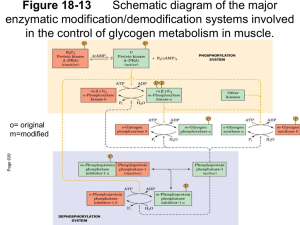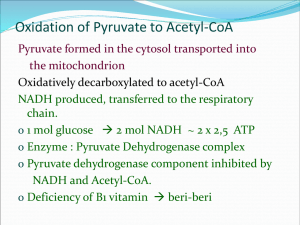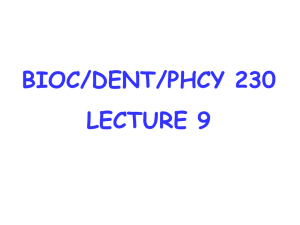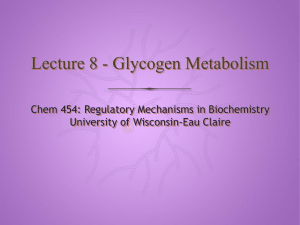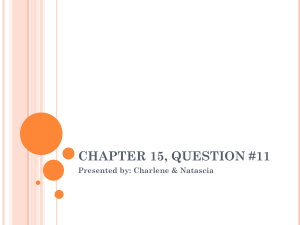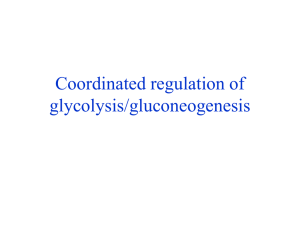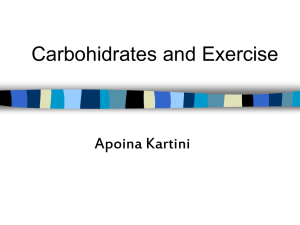Metabolism of Glycogen
advertisement
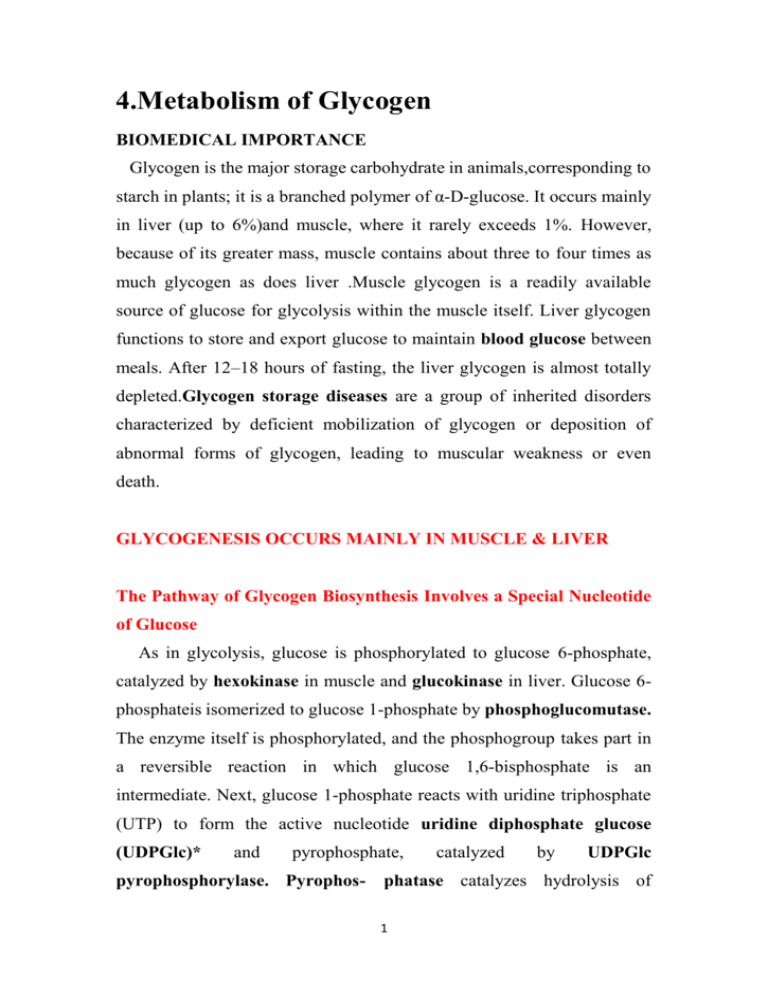
4.Metabolism of Glycogen BIOMEDICAL IMPORTANCE Glycogen is the major storage carbohydrate in animals,corresponding to starch in plants; it is a branched polymer of α-D-glucose. It occurs mainly in liver (up to 6%)and muscle, where it rarely exceeds 1%. However, because of its greater mass, muscle contains about three to four times as much glycogen as does liver .Muscle glycogen is a readily available source of glucose for glycolysis within the muscle itself. Liver glycogen functions to store and export glucose to maintain blood glucose between meals. After 12–18 hours of fasting, the liver glycogen is almost totally depleted.Glycogen storage diseases are a group of inherited disorders characterized by deficient mobilization of glycogen or deposition of abnormal forms of glycogen, leading to muscular weakness or even death. GLYCOGENESIS OCCURS MAINLY IN MUSCLE & LIVER The Pathway of Glycogen Biosynthesis Involves a Special Nucleotide of Glucose As in glycolysis, glucose is phosphorylated to glucose 6-phosphate, catalyzed by hexokinase in muscle and glucokinase in liver. Glucose 6phosphateis isomerized to glucose 1-phosphate by phosphoglucomutase. The enzyme itself is phosphorylated, and the phosphogroup takes part in a reversible reaction in which glucose 1,6-bisphosphate is an intermediate. Next, glucose 1-phosphate reacts with uridine triphosphate (UTP) to form the active nucleotide uridine diphosphate glucose (UDPGlc)* and pyrophosphate, catalyzed by UDPGlc pyrophosphorylase. Pyrophos-18phatase catalyzes hydrolysis of 1 pyrophosphate to 2 mol of inorganic phosphate, shifting the equilibrium of the main reaction by removing one of its products.Glycogen synthase catalyzes the formation of a glycoside bond between C1 of the activated glucose of UDPGlc and C4 of a terminal glucose residue of glycogen, liberating uridine diphosphate (UDP). A preexisting glycogen molecule, or “glycogen primer,” must be present to initiate this reaction. The glycogen primer may in turn be formed on a primer known as glycogenin,which is a 37-kDa protein that is glycosylated on a specific tyrosine residue by UDPGlc. Further glucose residues are attached in the 1→4 position to make a short chain that is a substrate for glycogen synthase.In skeletal muscle, glycogenin remains attached in the center of the glycogen molecule ,whereas in liver the number of glycogen molecules is greater than the number of glycogenin molecules. Branching Involves Detachment of Existing Glycogen Chains The addition of a glucose residue to a preexisting glycogen chain, or “primer,” occurs at the nonreducing,outer end of the molecule so that the “branches” of the glycogen “tree” become elongated as successive 1→4 linkages are formed . When the chain has been lengthened to at least 11 glucose residues, branching enzyme transfers a part of the 1→4 chain (at least six glucose residues) to a neighboring chain to form a 1→6 linkage, establishing a branch point. The branches grow by further additions of 1→4-glucosyl units and further branching. 2 - GLYCOGENOLYSIS IS NOT THE REVERSE OF GLYCOGENESIS BUT IS A SEPARATE PATHWAY . Glycogen phosphorylase catalyzes the rate-limiting step in glycogenolysis by promoting the phosphorylytic cleavage by inorganic phosphate (phosphorylysis; cf hych18drolysis) of the 1→4 linkages of glycogen to yield glucose 1-phosphate. The terminal glucosyl residues from the outermost chains of the glycogen molecule are removed sequentially until approximately four glucose residues remain on either side of a 1→6 branch . Another enzyme (_-[1v4]v_-[1v4] glucan transferase) transfers a trisaccharide unit from one branch to the other, exposing the 1→6 branch point.Hydrolysis of the 1→6 linkages requires the debranching enzyme. Further phosphorylase action can then proceed. The combined action of phosphorylase and these other enzymes leads to the complete breakdown of glycogen. The reaction catalyzed by phosphoglucomutase is reversible, so that glucose 6-phosphate can be formed from glucose 1-phosphate. In liver (and kidney), but not in muscle, there is a specific enzyme,glucose-6-phosphatase, that hydrolyzes glucose 6-phosphate, yielding glucose that is exported, leading to an increase in the blood glucose concentration. CYCLIC AMP INTEGRATES THE REGULATION OF GLYCOGENOLYSIS & GLYCOGENESIS The principal enzymes controlling glycogen metabolism—glycogen phosphorylase and glycogen synthase—are regulated by allosteric mechanisms and covalent modifications due to reversible phosphorylation and dephosphorylation of enzyme protein in response to hormone action .Cyclic AMP (cAMP) (Figure 18–5) is formed from 3 ATP by adenylyl cyclase at the inner surface of cell membranes and acts as an intracellular second messenger in response to hormones such as epinephrine, norepinephrine,and glucagon. cAMP is hydrolyzed by phosphodiesterase, so terminating hormone action. In liver, insulin increases the activity of phosphodiesterase. Phosphorylase Differs Between Liver & Muscle. In liver, one of the serine hydroxyl groups of active phosphorylase a is phosphorylated. It is inactivated by hydrolytic removal of the phosphate by protein phosphatase-1 to form phosphorylase b. Reactivation requires rephosphorylation catalyzed by phosphorylase kinase.Muscle phosphorylase is distinct from that of liver. It is a dimer, each monomer containing 1 mol of pyridoxal phosphate (vitamin B6). It is present in two forms: phosphorylase a, which is phosphorylated and active in either the presence or absence of 5′-AMP (its allosteric modifier);and phosphorylase b, which is dephosphorylated and active only in the presence of 5′-AMP. This occurs during exercise when the level of 5′-AMP rises, providing,by this mechanism, fuel for the muscle. Phosphorylase a is the normal physiologically active form of the enzyme. cAMP Activates Muscle Phosphorylase Phosphorylase in muscle is activated in response to epinephrine acting via cAMP. Increasing the concentration of cAMP activates cAMPdependent protein kinase, which catalyzes the phosphorylation by ATP of inactive phosphorylase kinase b to active phosphorylase kinase a, which in turn, by means of a further phosphorylation, activates phosphorylase b to phosphorylase a. 4 Ca2+ Synchronizes the Activation of Phosphorylase With Muscle Contraction. Glycogenolysis increases in muscle several hundred-fold immediately after the onset of contraction. This involves the rapid activation of phosphorylase by activation of phosphorylase kinase by Ca2+, the same signal as that which initiates contraction in response to nerve stimulation. Muscle phosphorylase kinase has four types of subunits—α, β, γ, and δ—in a structure represented as (αβγδ)4. The α and β subunits contain serine residues that are phosphorylated by cAMPdependent protein kinase. The δ subunit binds four Ca2+ and is identical to the Ca2+-binding protein calmodulin . The binding of Ca2+ activates the catalytic site of the γ subunit while the molecule remains in the dephosphorylated b configuration. However, the phosphorylated a form is only fully activated in the presence of Ca2+. A second molecule of calmodulin, or TpC (the structurally similar Ca2+-binding protein in muscle), can interact with phosphorylase kinase, causing further activation. Thus, activation of muscle contraction and glycogenolysis are carried out by the same Ca2+-binding protein, ensuring their synchronization. Glycogenolysis in Liver Can Be cAMP-Independent In addition to the action of glucagon in causing formation of cAMP and activation of phosphorylase in liver,_1-adrenergic receptors mediate stimulation of glycogenolysis by epinephrine and norepinephrine. This involves a cAMP-independent mobilization of Ca2+ from mitochondria into the cytosol, followed by the stimulation of a Ca2+/calmodulinsensitive phosphorylase kinase. cAMP-independent glycogenolysis is 5 also caused by vasopressin, oxytocin, and angiotensin II acting through calcium or the phosphatidylinositol bisphosphate pathway . Protein Phosphatase-1 Inactivates Phosphorylase Both phosphorylase a and phosphorylase kinase a are dephosphorylated and inactivated by protein phosphatase-1. Protein phosphatase-1 is inhibited by a protein, inhibitor-1, which is active only after it has been phosphorylated by cAMP-dependent protein kinase. Thus, cAMP controls both the activation and inactivation of phosphorylase . Insulin reinforces this effect by inhibiting the activation of phosphorylase b. It does this indirectly by increasing uptake of glucose, leading to increased formation of glucose 6-phosphate, which is an inhibitor of phosphorylase kinase. - Glycogen Synthase & Phosphorylase Activity Are Reciprocally Regulated. Like phosphorylase, glycogen synthase exists in either a phosphorylated or nonphosphorylated state. However,unlike phosphorylase, the active form is dephosphorylated (glycogen synthase a) and may be inactivated to glycogen synthase b by phosphorylation on serine residues by no fewer than six different protein kinases.Two of the protein kinases are Ca2+/calmodulindependent (one of these is phosphorylase kinase). Another kinase is cAMP-dependent protein kinase, which allows cAMP-mediated hormonal action to inhibit glycogen synthesis synchronously with the activation of glycogenolysis. Insulin also promotes glycogenesis in muscle at the same time as inhibiting glycogenolysis by raising glucose 6-phosphate concentrations, 6 which stimulates the dephosphorylation and activation of glycogen synthase. Dephosphorylation of glycogen synthase b is carried out by protein phosphatase-1, which is under the control of cAMP-dependent protein kinase. - REGULATION OF GLYCOGEN METABOLISM IS EFFECTED BY A BALANCE IN ACTIVITIES BETWEEN GLYCOGEN SYNTHASE & PHOSPHORYLASE. Not only is phosphorylase activated by a rise in concentration of cAMP (via phosphorylase kinase), but glycogen synthase is at the same time converted to the inactive form; both effects are mediated via cAMPdependent protein kinase. Thus, inhibition of glycogenolysis enhances net glycogenesis, and inhibition of glycogenesis enhances net glycogenolysis. Furthermore, the dephosphorylation of phosphorylase a, phosphorylase kinase a, and glycogen synthase b is catalyzed bya single enzyme of wide specificity—protein phosphatase-1. In turn, protein phosphatase-1 is inhibited by cAMP-dependent protein kinase via inhibitor-1.Thus, glycogenolysis can be terminated and glycogenesis can be stimulated synchronously, or vice versa, because both processes are keyed to the activity of cAMP-dependent protein kinase. Both phosphorylase kinase and glycogen synthase may be reversibly phosphorylated in more than one site by separate kinases and phosphatases.These secondary phosphorylations modify the sensitivity of the primary sites to phosphorylation and dephosphorylation (multisite phosphorylation). What is more, they allow insulin, via glucose 6phosphate elevation,to have effects that act reciprocally to those of cAMP . 7 CLINICAL ASPECTS Glycogen Storage Diseases Are Inherited “Glycogen storage disease” is a generic term to describe a group of inherited disorders characterized by deposition of an abnormal type or quantity of glycogen in the tissues. The principal glycogenoses are summarized in Table 1. Deficiencies of adenylyl kinase and cAMPdependent protein kinase have also been rech18 ported. Some of the conditions described have benefited from liver transplantation. SUMMARY • Glycogen represents the principal storage form of carbohydrate in the mammalian body, mainly in the liver and muscle. • In the liver, its major function is to provide glucose for extrahepatic tissues. In muscle, it serves mainly as a ready source of metabolic fuel for use in muscle. • Glycogen is synthesized from glucose by the pathway of glycogenesis. It is broken down by a separate pathway known as glycogenolysis. Glycogenolysis leads to glucose formation in liver and lactate formation in muscle owing to the respective presence or absence of glucose-6phosphatase. • Cyclic AMP integrates the regulation of glycogenolysis and glycogenesis by promoting the simultaneous activation of phosphorylase and inhibition of glycogen synthase. Insulin acts reciprocally by inhibiting glycogenolysis and stimulating glycogenesis. • Inherited deficiencies in specific enzymes of glycogen metabolism in both liver and muscle are the causes of glycogen storage diseases. 8 9
